Discover 20 hidden attractions, cool sights, and unusual things to do in Peoria (United States). Don't miss out on these must-see attractions: Dozer Park, Luthy Botanical Garden, and Peoria City Hall. Also, be sure to include Spirit of Peoria in your itinerary.
Below, you can find the list of the most amazing places you should visit in Peoria (Illinois).
Table of Contents
Dozer Park
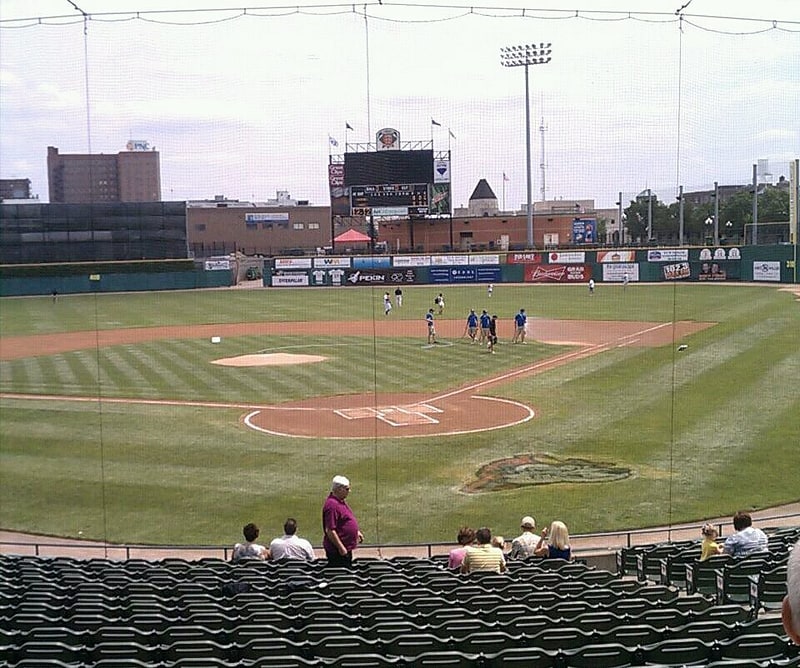
Stadium in Peoria, Illinois. Dozer Park, originally O'Brien Field and formerly Chiefs Stadium, is a baseball field located in downtown Peoria, Illinois. It is the home of the Peoria Chiefs, the High-A Central affiliate of the St. Louis Cardinals; the Chiefs previously played at Meinen Field. The college baseball team of Bradley University also uses the field. It opened on May 24, 2002.[1]
Address: 730 SW Jefferson Ave, 61605-3901 Peoria (South Peoria)
Luthy Botanical Garden

Botanical garden in Peoria, Illinois. George L. Luthy Memorial Botanical Garden, usually just Luthy Botanical Garden, is a 4.5 acres botanical garden and conservatory located in Glen Oak Park, near the corner of Prospect Avenue and Gift Avenue in Peoria, Illinois, United States.
The garden was established in 1951. It now contains more than 300 genera, with an emphasis on roses, perennials, annuals, hosta, hemerocallis, and herbs. Specific gardens include an all-season garden, herb garden, perennial garden, rose garden, viburnum collection, wildlife garden, and woodland garden. The conservatory is 2,500 square feet (230 m2) and features tropical plants, orchids, and seasonal displays.
The garden is named after George Littlewood Luthy, who was president of Peoria's Commercial National Bank (now part of Commerce Bank) and of the Peoria Park District, which owns the garden.
It is open daily. Garden admission is free; a fee is charged for the conservatory.[2]
Address: 2520 N Prospect Rd, 61603-2129 Peoria (East Bluff)
Peoria City Hall
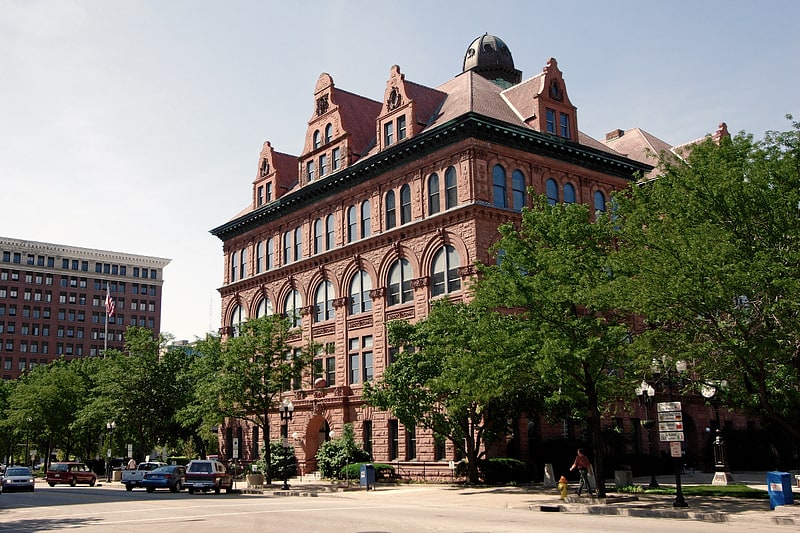
Building in Peoria, Illinois. Peoria City Hall, located in the United States city of Peoria, Illinois, was designed and built by Reeves and Baillee in 1897 for US$271,500. The city hall was dedicated January 5 to January 7, 1899. The building is still Peoria's city hall and is listed on the National Register of Historic Places. The Peoria Civic Center was built behind it in 1982.[3]
Address: 419 Fulton St, Peoria
Spirit of Peoria
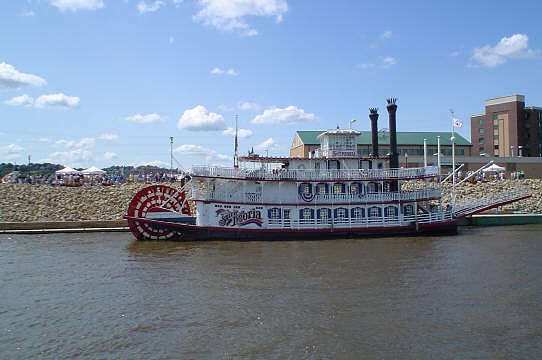
Riverboat. Spirit of Peoria is a riverboat that normally runs in the Peoria, Illinois area on the Illinois River watershed. The boat participated in the 2004 Grand Excursion. Spirit of Peoria is a true paddleboat, actually using its paddlewheel for propulsion, unlike some modern riverboats with purely cosmetic wheels.
The boat was designed by architect Alan Bates, and built in 1988 at the Walker Boat Yard in Paducah, Kentucky, making it the first paddleboat vessel built there. The propulsion system was designed by Norm Rittenhouse, with steering by Custom Hydraulics.
Spirit of Peoria has no propellers or thrusters, and is powered by twin Caterpillar 3412 diesel gensets, producing 700 kilowatts combined in 208 volt 3-phase voltage. The AC power is rectified to DC which in turn powers two locomotive traction motors, which drive the paddlewheel via two 40-foot-long (12 m) by 1-foot-wide (0.30 m) chains. This allows the boat to be comparatively fast and efficient, burning approximately 15 US gallons (57 l) of diesel fuel an hour, with a top speed of over 15 mph (24 km/h). The dry weight is about 275 tons, with a passenger capacity of 385. The boat carries 3,500 US gallons (13,000 l) of fuel and 2,500 US gallons (9,500 l) of water.
The regular area of travel of the boat ranges from Pere Marquette State Park near Grafton, Illinois to Starved Rock State Park near Ottawa, Illinois. The boat is owned and captained by G. Alex Grieves, and co-captained by Alice Grady and Dylan Masonholder.[4]
Address: 100 Northeast Water Street, 61602-1322 Peoria
Madison Theatre
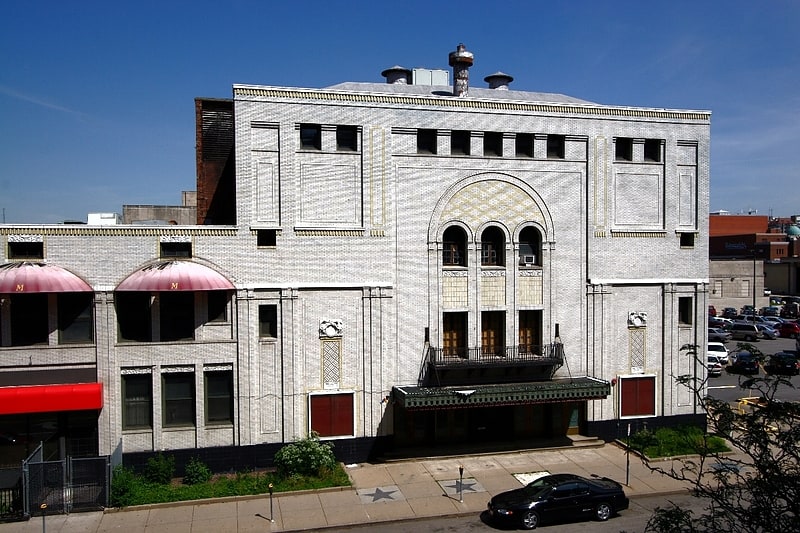
Theater in Peoria, Illinois. Madison Theatre is a historic theater in Peoria, Illinois, United States that opened on October 16, 1920, as a silent picture theatre.[5]
Peace and Harvest
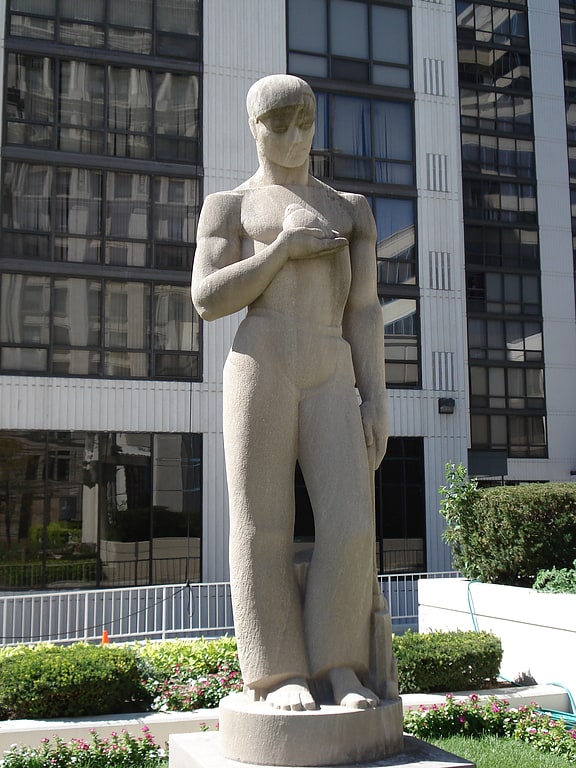
Work of art. Peace and Harvest are two 8-foot tall limestone statues in downtown Peoria, Illinois, United States. The male and female figures represent peace and harvest respectively. The statues were sculpted by Chicagoan Mary Andersen Clark as part of the Works Progress Administration's Federal Art Project, and were added to the National Register of Historic Places in 1988.
The statues, created in 1938 and 1939, were dedicated on September 3, 1939 in front of the Peoria Municipal Tuberculosis Sanitarium, just north of the current Forest Park Nature Center, and stood at the site until the sanitarium closed in 1975. They then moved to Peoria Courthouse Plaza from 1975 to 1988, then were stored in a Peoria firehouse until 1992, causing them to briefly lose their National Register status. In June 1992, the statues were placed at their current site in front of the Becker Building at the corner of Jefferson and Main Streets.[6]
Pettengill–Morron House
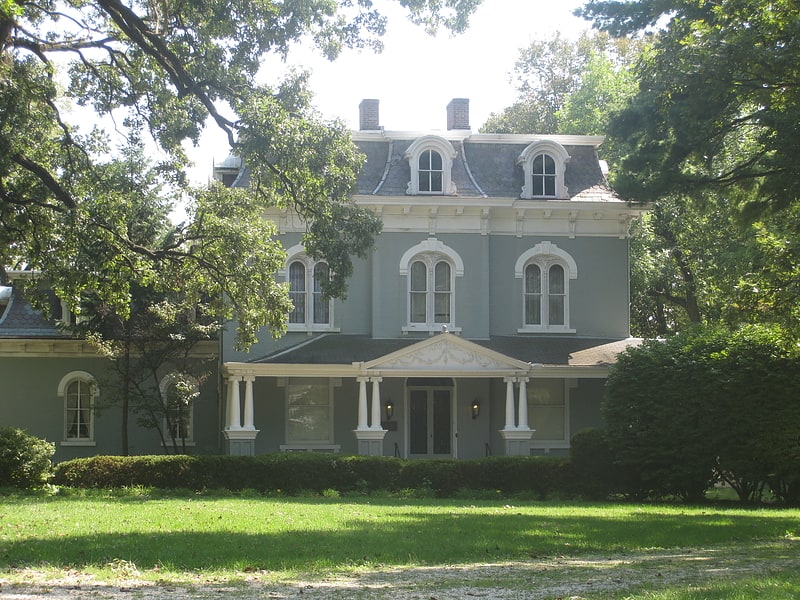
Building in Peoria, Illinois. The Pettengill–Morron House, or Morron House, is a house located in the American city of Peoria, Illinois. The 1868 mansion was originally built for Moses Pettengill, a hardware store owner who came to Peoria from New Hampshire in 1833. When Pettengill arrived in Peoria there were 150 people, 30 log cabins and three frame houses.
The original house on the site, an 1862 construction, was destroyed by fire in 1865. The current building was constructed in 1868 in the Second Empire style, and a colonial revival porch and porte-cochere were added in 1900. Its original address was 464 Moss Avenue before Peoria's address renumbering in the 1950s. The last resident was Miss Jean Morron, who lived there from 1953 until she died in 1966; the Peoria Historical Society acquired the house in 1967.
The house was listed on the U.S. National Register of Historic Places on April 2, 1976. The home is also listed as a contributing member to the West Bluff Historic District, which was added to the National Register in December 1976.
The Peoria Historical Society operates this house and the Judge Flanagan Residence as historic house museums.[7]
Address: 1212 W Moss Ave, 61606-1736 Peoria (West Bluff)
Wheels O' Time
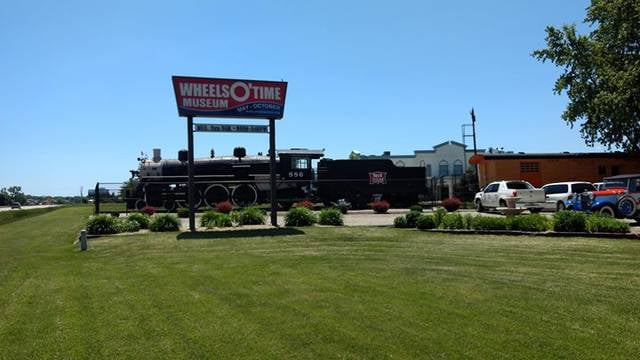
Museum, Specialty museum, History museum
Address: 1710 W Woodside Dr, 61525-9571 Dunlap
Cedar Street Bridge
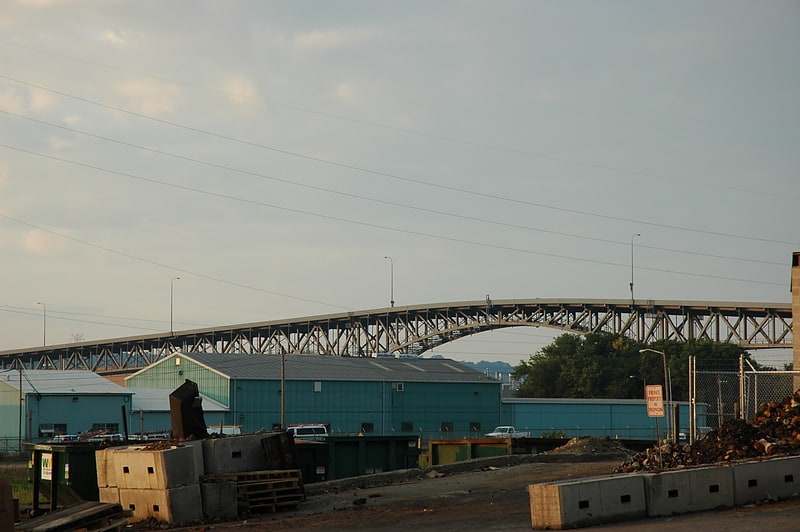
Truss arch bridge in Peoria, Illinois. The Cedar Street Bridge carries Illinois Route 8 and Illinois Route 116 over the Illinois River. The bridge is a steel arch design that rises approximately 70 to 80 feet above the surface of the river. The name of the bridge comes from the original name of its street on the Peoria side of the river; the street itself is now called MacArthur Highway, while the bridge is still referred to as Cedar Street.
Completed in 1933, it received the Award of Merit plaque of the American Institute of Steel Construction as the most beautiful bridge in class A (costing more than $1,000,000) for that year.[8]
Cathedral of Saint Mary of the Immaculate Conception
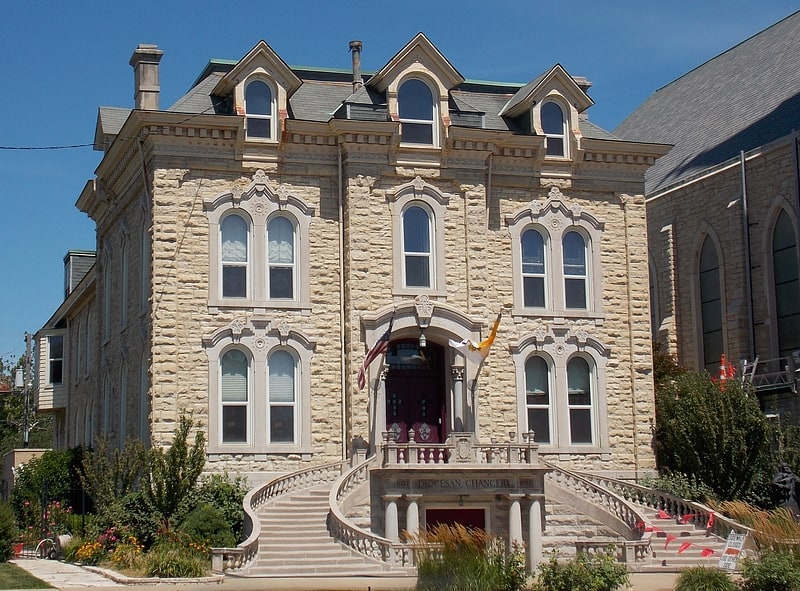
Cathedral in Peoria, Illinois. The Cathedral of Saint Mary of the Immaculate Conception is a cathedral of the Catholic Church located in Peoria, Illinois, United States. It is the seat of the Diocese of Peoria, where the Catholic televangelist and sainthood candidate Archbishop Fulton J. Sheen was born and raised, and ordained a priest. Since 2019, the cathedral has been his place of burial. The cathedral is listed on the National Register of Historic Places as a contributing property in the North Side Historic District.[9]
Address: 607 NE Madison Ave, 61603 Peoria (North Valley)
Caterpillar
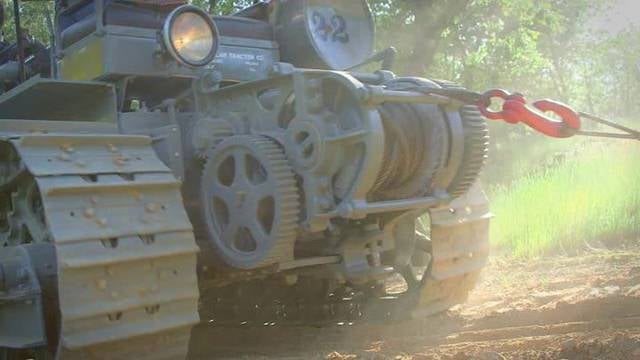
Museum, Visitor center, Entertainment
Address: 110 SW Washington St, 61602-2501 Peoria
Bob Michel Bridge
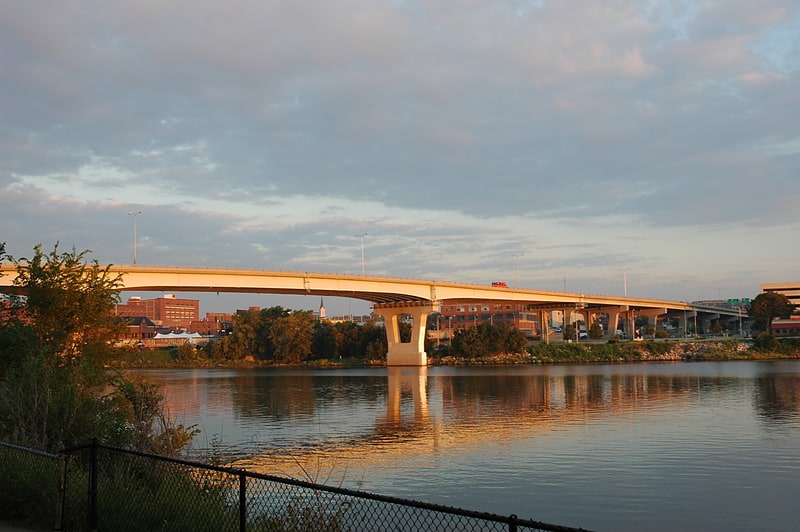
Bridge in East Peoria, Illinois. The Bob Michel Bridge carries Illinois Route 40 over the Illinois River 0.75 miles up-river from the Cedar Street Bridge. Illinois 40 terminates at an interchange with Interstate 74 just east of the bridge. The bridge serves as a direct surface route from a major commercial center in East Peoria to the Civic Center in downtown Peoria. When completed in 1993, the Bob Michel Bridge replaced the antiquated Franklin Street Bridge, a bascule and truss bridge, which had been located on an adjacent site since 1913. The Bob Michel Bridge is the only river crossing in the Peoria area to accommodate pedestrians and cyclists.
Prior to the development of the area as a commercial center, the Michel Bridge served a largely industrial area in East Peoria, including many buildings owned by nearby Caterpillar, Inc. The bridge was located at the end of an exit named "Industrial Spur". It has since been renamed to "Riverfront Drive" to account for the new commercial complex.
The Bob Michel Bridge is named after former Congressman Robert H. Michel, a Peoria-area Republican who served as a Congressman from 1957 to 1995 and as House Minority Leader from 1981 until his retirement.
The bridge is located at mile 162.3 of the Illinois River.[10]
St. Paul's Episcopal Church
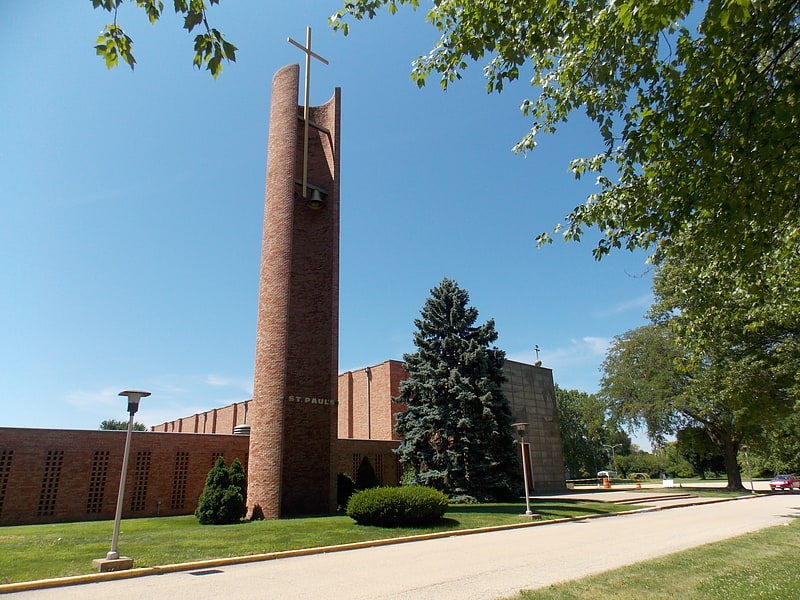
Parish church in Peoria, Illinois. St. Paul's Episcopal Church is an Episcopal parish church in Peoria, Illinois, United States. It is the former cathedral of the Diocese of Quincy.[11]
Address: 3601 North North Street, 61604-1548 Peoria (Central Peoria)
Peoria Heights
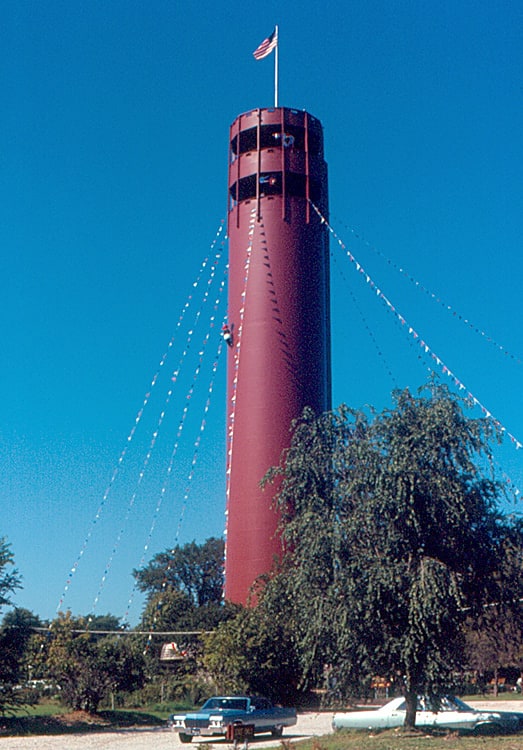
Village in Illinois. Peoria Heights is a village lying almost entirely in Peoria County in the U.S. state of Illinois. The population was 6,156 at the 2010 census, down from 6,635 in 2000. Peoria Heights is a suburb of Peoria and is surrounded by the city except for its eastern boundary on Peoria Lake, a relatively wider section of the Illinois River. It is part of the Peoria, Illinois Metropolitan Statistical Area.[12]
McClugage Bridge
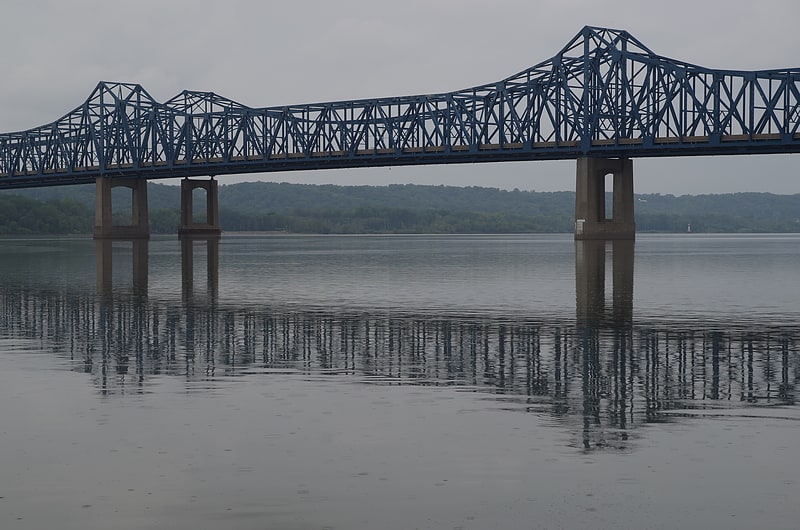
Cantilever bridge. The McClugage Bridge carries U.S. Route 150 over Upper Peoria Lake & Peoria Lake in the Illinois River in the US state of Illinois. The bridge's official name honors David H. McClugage, mayor of Peoria from 1937 to 1941. The crossing is actually composed of two bridges, one carrying westbound traffic and one carrying eastbound traffic.[13]
Address: Illinois River, Peoria
Scottish Rite Cathedral

Cathedral in Peoria, Illinois. The Scottish Rite Cathedral in Peoria, Illinois is a church-style building that houses the Scottish Rite Bodies of the Valley of Peoria. The building is at 400 NE Perry Avenue, at the corner with Spalding Avenue. The cathedral is listed as a contributing property to Peoria's North Side Historic District.
The Scottish Rite Bodies of the Valley of Peoria was established in Yates City, Illinois on 25 February 1867, and moved to Peoria in 1869. The body had 3 meeting locations in downtown Peoria before the Scottish Rite Cathedral. The cornerstone for the Scottish Rite Cathedral was laid on 7 May 1924.
The cathedral design features flying buttresses and symbolic stained glass windows. The cathedral has an auditorium with a stage and 900 seats.
The Masonic membership in the Valley of Peoria was near 15,000 at one time, but had dropped to 1,200 by 2019, and was having trouble affording the maintenance of the building. Kim Blickenstaff, who grew up in nearby East Peoria, bought the Cathedral on April 26, 2019, for $490,000, with plans to put it in a trust, operate it as a community venue, and allow Scottish Rite members to use the venue in perpetuity.[14]
Address: 400 NE Perry Ave, 61603-3679 Peoria (North Valley)
Murray Baker Bridge
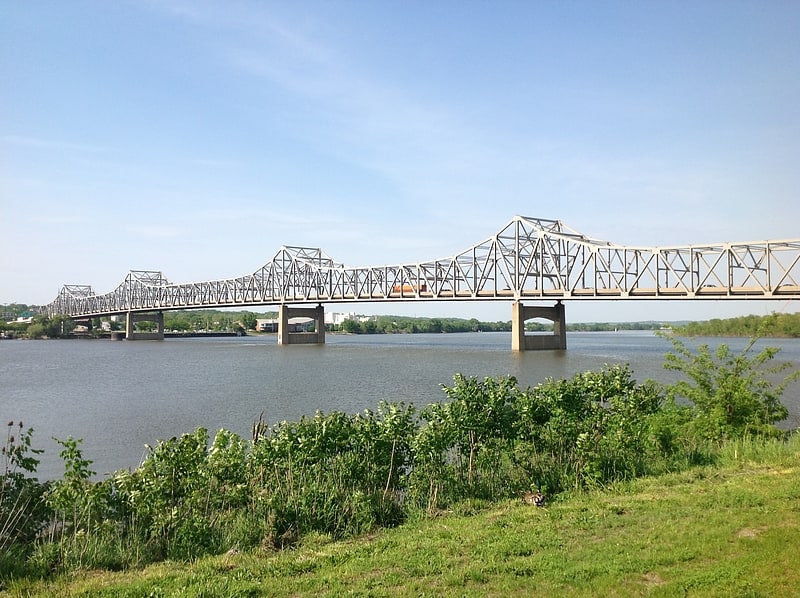
Bridge in Illinois. The Murray Baker Bridge is a landmark cantilever bridge that carries Interstate 74 and Illinois Route 29 over the Illinois River from downtown Peoria to East Peoria in central Illinois. According to the Illinois Department of Transportation, the Murray Baker Bridge was built in 1958, and had an original length of 3,216 feet.
The bridge itself is a single cantilever bridge, with two lanes in each direction. Because it has no shoulders, the Baker Bridge is not up to modern Interstate standards.
The bridge is named for Murray M. Baker, who was the first vice president of the company that eventually became Caterpillar. Baker convinced the Holt Manufacturing Company to move to Peoria in 1909. Holt merged with C.L. Best Gas Tractor Co. and became Caterpillar in 1925.[15]
Springdale Cemetery
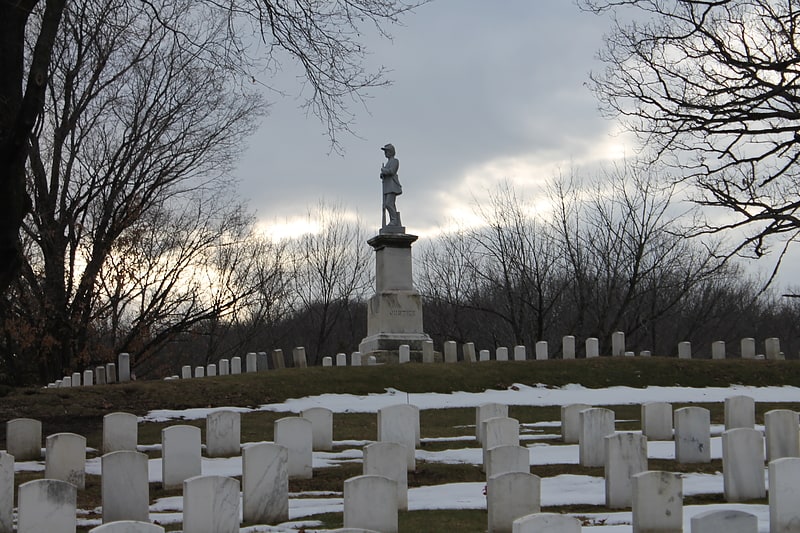
Cemetery in Peoria, Illinois. Springdale Cemetery is a historic, non-sectarian, active cemetery in the United States city of Peoria, Illinois. It was chartered in 1855, received its first interment in 1857. Almost 78,000 individuals are buried at the cemetery. It contains a public mausoleum and 15 private mausoleums.
The property was acquired in 1854, and the first interment took place in April 1857. The Cemetery is an active, non-sectarian burial ground, and the property contains 15 private mausoleums. The historic gatehouse, constructed in 1901, was razed in 2010. The public mausoleum, which was designed by the Chicago architectural firm of Lovell & Lovell, was completed in 1929 and has been expanded twice. The cemetery once grew to over 360 acres (1.46 km2) but has since retracted to its present size of 223 acres. The property includes six and a half miles of winding driveways. The cemetery is the final resting place for nearly 78,000 individuals from the Peoria area. The property is not fully developed, and as a result, the Cemetery can accommodate another 50,000 burials. The Cemetery permits traditional burial in the ground, entombment in the mausoleum, inurnment of cremated remains in crypts and in burial lots, and a scattering garden. The Cemetery is actively planning for green burial.[16]
Address: 3014 N Prospect Rd, Peoria (East Bluff)
Taft Homes
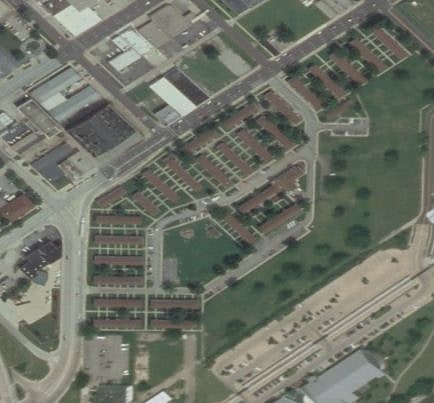
Housing. The Taft Homes are a public housing project located off the Illinois River in Peoria, Illinois. In total there are 200 apartments in Taft, housed in separate wood-framed buildings. The Taft Homes are currently in the early stages of a redevelopment project that calls for the demolition of all current units, with the lots then transformed into mixed-income housing.[17]
Grand Army of the Republic Memorial Hall
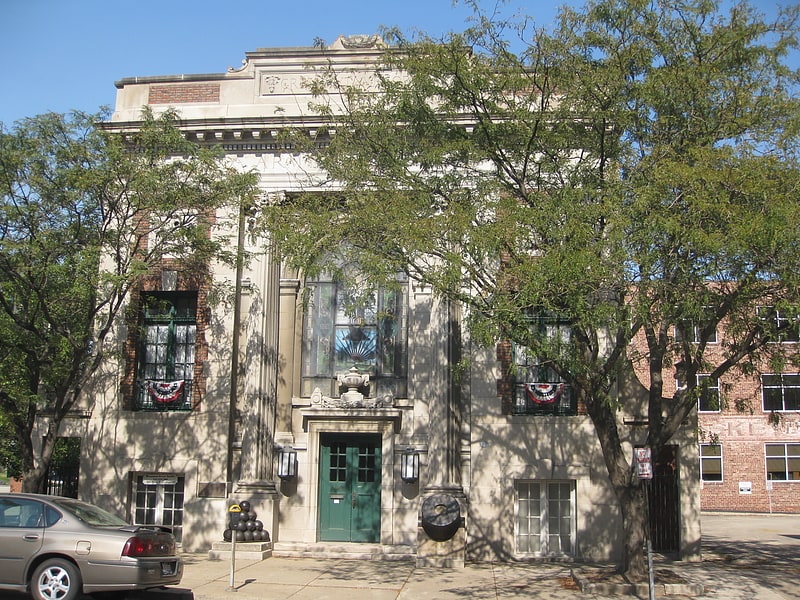
Building in Peoria, Illinois. The Grand Army of the Republic Memorial Hall was constructed as a memorial to American Civil War soldiers in Peoria, Illinois, United States in 1909. It was designed by Hewett & Emerson. The Classical Revival hall was dedicated to Joseph B. Greenhut, Captain of Company K, 82nd Illinois Volunteer Infantry Regiment. The building was added to the National Register of Historic Places on July 13, 1976, and was listed as an example of Beaux-Arts architecture.[18]